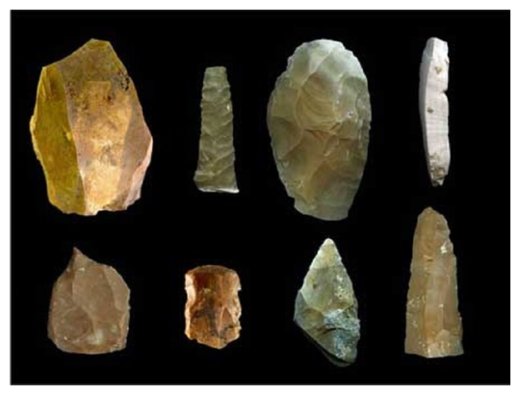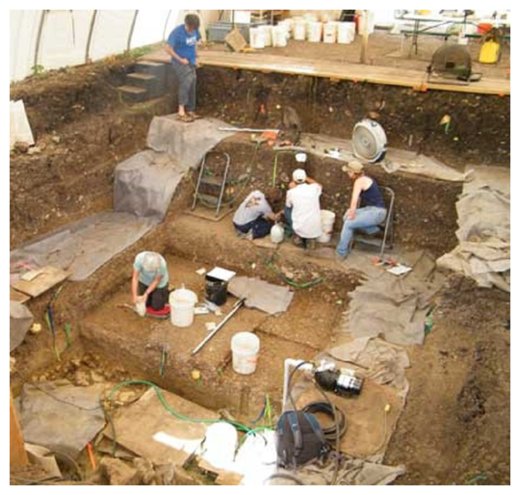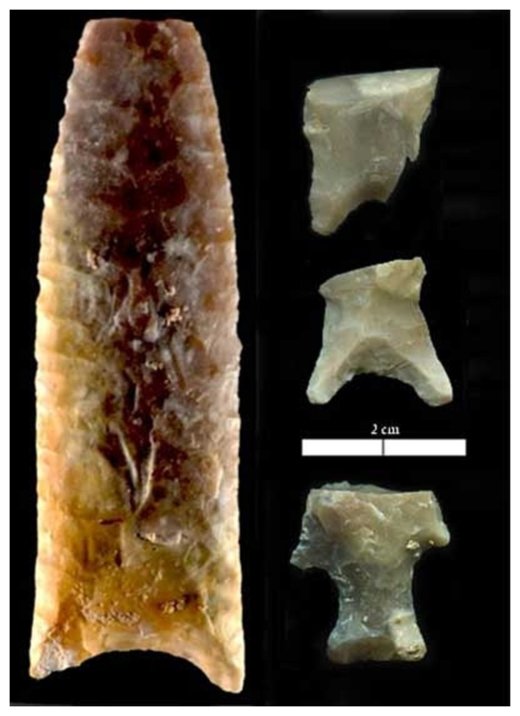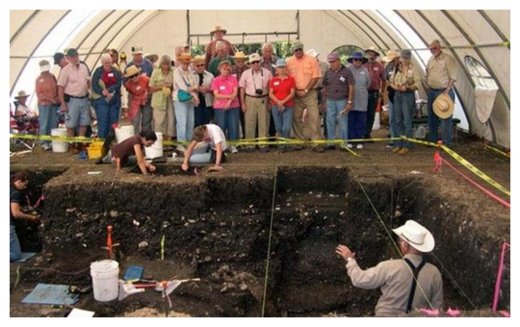
But then, years later, they made an even more powerful find in the same place — another layer of artifacts that were older still.
About a half-hour north of Austin and a meter deep in water-logged silty clay, researchers have uncovered evidence of human occupation dating back as much as 16,700 years, including fragments of human teeth and more than 90 stone tools.
In addition to being some of the oldest yet found in the American West, the artifacts are rare traces of a culture that predated the culture known as Clovis, whose distinctively shaped stone tools found across North America have consistently been dated to about 13,000 years ago.
Indeed, an entire generation of anthropologists was taught that Clovis represented the continent's first inhabitants.
But, along with a handful of other pre-Clovis finds, the Texas tools add to the mounting evidence that humans arrived on the continent longer ago than was once thought, said Dr. D. Clark Wernecke, director of the Gault School of Archaeological Research.
"The most important takeaway is that people were in the New World much earlier than we used to believe," Wernecke said.
"We were all taught [North America was first populated] 13,500 years ago, and it appears that people arrived 15,000 to 20,000 years ago."
The location in Texas where the new finds were made, known as the Gault site, was first identified in the 1920s, but it wasn't until the 1990s that archaeologists discovered the first tools, like tapered-oval spear heads, that were clear signs of the ancient Clovis culture.
It was those finds that Wernecke and his colleagues went to investigate further, when they began working at the Gault site in 2002.

After several years of digging test pits and making chance finds, the team ended up focusing on two of the most striking parts of the site.
The first part, known as Area 12, revealed an unusual "pavement" constructed out of cobbles buried deep beneath the surface.
"[It's] a roughly two-by-three-meter rectangular gravel pad about 10 centimeters thick of rounded river gravels in a narrow range of sizes, with artifacts of at least Clovis age on and around it," Wernecke said.
"The indications from the surrounding data are that it had a structure on it."
The presence of Clovis-era stone tools suggested that the paved floor dated to about 13,000 years ago.
The team kept digging, and about 1 meter below the pavement and the Clovis tools, they found nine more flakes of shaped stone, along with a scattering of animal bones.
Assuming that material found below the Clovis pavement must be older than Clovis, the researchers were intrigued. But there was not much to go on.
"In Area 12, you have the pavement, lithics and bone, and not much else," Wernecke said.
However, the team also turned its attention to another area nearby, where it discovered significantly more, and larger, artifacts that were also older than Clovis.
Here, at a spot named Area 15, the researchers first found a few more stone tools fashioned in the signature Clovis style. But several centimeters below that, an abundance of new material appeared — including human teeth.
Among a pile of limestone rocks, the team discovered the enamel caps of four adjacent teeth from a young adult female.
No human bones were found, and enamel can't be radiocarbon dated, Wernecke noted, so details about the woman — like how and when she lived and died — remain a mystery for now.
However, within this same, deep, older-than-Clovis layer of sediment, the researchers unearthed yet another compelling find — more than 90 stone tools, fashioned in a style that clearly wasn't Clovis.

But many of the newly found, deeper artifacts didn't fit that description.
"The morphology is completely different," Wernecke said. "They are not lanceolate points with basal thinning.
"Three of them are very small stemmed points, and the fourth is a somewhat thick sort of lanceolate point.
In addition to the 90 tools, the artifacts include more than 160,000 stone flakes left over from the tool-making process. And they, too, are different from the flakes found with Clovis tools, Wernecke said.
"The flaking patterns are also completely different," he said.
"These were not made using Clovis technology."
But the fact that these artifacts were different from, and deeper than, the Clovis points didn't necessarily prove that they were older.
To establish their age, Wernecke and his colleagues submitted 18 of the artifacts to a lab for optically stimulated luminescence dating — a process that analyzes tiny grains in the soils to reveal when they were last exposed to sunlight, thereby giving a sense of how long they've been buried.
The results showed that the artifacts were between 13,200 to 16,700 years old.
At their most ancient, that's some 3,000 years older than the earliest known signs of Clovis culture anywhere in North America.
"We compared these [dates] with relative dating of artifacts and radiocarbon dates wherever possible," Wernecke added. "All seem to agree well."
The discovery of all of these older-than-Clovis artifacts raises tantalizing questions about what that earlier culture was like, and how it compared to the Clovis culture.
According to Wernecke, the pre-Clovis tools suggest that their makers were likely direct predecessors of the Clovis.
Many aspects of their technology — like how they made biface blades — were similar but not identical, he said.
"Blade technology does not seem to have changed a lot — a little bit in technique, but both cultures were making similar blades," he said.
"Likewise, many of the tools are the same basic tools — easily recognizable to either technological culture but made in a different fashion. A different set of technological tools and instructions were used to arrive at similar tool types."
This continuity in technology might indicate a similar continuity of culture, Wernecke added, a gradual transition from one culture to the next.
"You would logically expect some similarity," he said. "If people adopted a new technology, some of the old would hang around.
"If [the tools] were completely different, you would expect to find another culture in between [the Clovis and older-than-Clovis layers], or evidence for total replacement of the population."
Much more work remains to be done at the Gault site, Wernecke said.
But the discoveries made there so far have enormous implications for our understanding of the history of human migration and the peopling of the Americas, Wernecke said.
"In 1590, [Spanish missionary and naturalist] Jose de Acosta wrote that the people in the New World were primitive humans who must have walked here, and we have built on that premise ever since," he said.
"But it was not possible to walk here until much later, with 3-mile-high glaciers in the way.
"If people got here 15,000 to 20,000 years ago, they had to have come along the coast in boats."
Moreover, he added, the diversity of artifacts uncovered at the Gault site also shows that the continent's earliest peoples were not a static or monolithic group.
"We are beginning to understand that the first peoples in the new world were just like us," Wernecke said, "intelligent, inventive, creative — and they found ways to adapt to a rapidly changing world."
Wernecke and his colleagues presented their findings at the 2015 meeting of the Plains Anthropological Conference.




Reader Comments
to our Newsletter